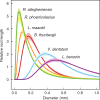Nutrient foraging strategies are associated with productivity and population growth in forest shrubs
- PMID: 28119293
- PMCID: PMC5604599
- DOI: 10.1093/aob/mcw271
Nutrient foraging strategies are associated with productivity and population growth in forest shrubs
Abstract
Background and aims: Temperate deciduous forest understoreys are experiencing widespread changes in community composition, concurrent with increases in rates of nitrogen supply. These shifts in plant abundance may be driven by interspecific differences in nutrient foraging (i.e. conservative vs. acquisitive strategies) and, thus, adaptation to contemporary nutrient loading conditions. This study sought to determine if interspecific differences in nutrient foraging could help explain patterns of shrub success and decline in eastern North American forests.
Methods: Using plants grown in a common garden, fine root traits associated with nutrient foraging were measured for six shrub species. Traits included the mean and skewness of the root diameter distribution, specific root length (SRL), C:N ratio, root tissue density, arbuscular mycorrhizal colonization and foraging precision. Above- and below-ground productivity were also determined for the same plants, and population growth rates were estimated using data from a long-term study of community dynamics. Root traits were compared among species and associations among root traits, measures of productivity and rates of population growth were evaluated.
Key results: Species fell into groups having thick or thin root forms, which correspond to conservative vs. acquisitive nutrient foraging strategies. Interspecific variation in root morphology and tissue construction correlated with measures of productivity and rates of cover expansion. Of the four species with acquisitive traits, three were introduced species that have become invasive in recent decades, and the fourth was a weedy native. In contrast, the two species with conservative traits were historically dominant shrubs that have declined in abundance in eastern North American forests.
Conclusions: In forest understoreys of eastern North America, elevated nutrient availability may impose a filter on species success in addition to above-ground processes such as herbivory and overstorey canopy conditions. Shrubs that have root traits associated with rapid uptake of soil nutrients may be more likely to increase in abundance, while species without such traits may be less likely to keep pace with more productive species.
Keywords: Below-ground dynamics; deciduous forest understorey; foraging strategies; functional traits; nutrient acquisition; rhizosphere; root economics spectrum; root morphology; woody shrubs.
© The Author 2017. Published by Oxford University Press on behalf of the Annals of Botany Company. All rights reserved. For Permissions, please email: journals.permissions@oup.com
Figures




References
-
- Aber JD, Goodale CL, Ollinger SV, et al.2003. Is nitrogen deposition altering the nitrogen status of northeastern forests? Bioscience 53: 375–389.
-
- Adams TS, McCormack ML, Eissenstat DM.. 2013. Foraging strategies in trees of different root morphology: the role of root lifespan. Tree Physiology 33: 940–948. - PubMed
-
- Aikens ML, Ellum D, McKenna JJ, Kelty MJ, Ashton MS.. 2007. The effects of disturbance intensity on temporal and spatial patterns of herb colonization in a southern New England mixed-oak forest. Forest Ecology and Management 252: 144–158.
-
- Beckage B, Kloeppel BD, Yeakley JA, Taylor SF, Coleman DC.. 2008. Differential effects of understory and overstory gaps on tree regeneration. Journal of the Torrey Botanical Society 135: 1–11.
Publication types
MeSH terms
Substances
LinkOut - more resources
Full Text Sources
Other Literature Sources
Miscellaneous

